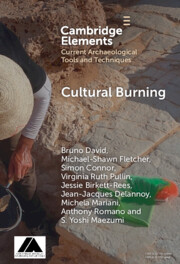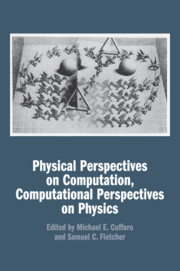63 results

Cultural Burning
-
- Published online:
- 10 May 2024
- Print publication:
- 06 June 2024
-
- Element
-
- You have access
- Open access
- HTML
- Export citation
Agricultural Research Service Weed Science Research: Past, Present, and Future
-
- Journal:
- Weed Science / Volume 71 / Issue 4 / July 2023
- Published online by Cambridge University Press:
- 16 August 2023, pp. 312-327
-
- Article
-
- You have access
- Open access
- HTML
- Export citation
Economic evaluation and costs of remote patient monitoring for cardiovascular disease in the United States: a systematic review
-
- Journal:
- International Journal of Technology Assessment in Health Care / Volume 39 / Issue 1 / 2023
- Published online by Cambridge University Press:
- 28 April 2023, e25
-
- Article
-
- You have access
- Open access
- HTML
- Export citation
Championing Dementia Education: Adapting an Effective Scottish Dementia Education Program for Canadian Acute Health Care Providers
-
- Journal:
- Canadian Journal on Aging / La Revue canadienne du vieillissement / Volume 42 / Issue 1 / March 2023
- Published online by Cambridge University Press:
- 10 November 2022, pp. 165-176
-
- Article
-
- You have access
- Open access
- HTML
- Export citation
Leveraging the ExpandNet framework and operational partnerships to scale-up brief Cognitive Behavioral Therapy in VA primary care clinics
-
- Journal:
- Journal of Clinical and Translational Science / Volume 6 / Issue 1 / 2022
- Published online by Cambridge University Press:
- 20 July 2022, e95
-
- Article
-
- You have access
- Open access
- HTML
- Export citation
Enhanced Atom Probe Imaging using Generalised Field Evaporation Models
-
- Journal:
- Microscopy and Microanalysis / Volume 27 / Issue S1 / August 2021
- Published online by Cambridge University Press:
- 30 July 2021, pp. 404-406
- Print publication:
- August 2021
-
- Article
-
- You have access
- Export citation
Politics and the Life Sciences: The Rise of a New Framework
-
- Journal:
- Politics and the Life Sciences / Volume 39 / Issue 1 / Spring 2020
- Published online by Cambridge University Press:
- 11 November 2019, pp. 1-3
-
- Article
- Export citation
Fast Continuum Models for Atom Probe Simulation and Reconstruction
-
- Journal:
- Microscopy and Microanalysis / Volume 25 / Issue S2 / August 2019
- Published online by Cambridge University Press:
- 05 August 2019, pp. 288-289
- Print publication:
- August 2019
-
- Article
-
- You have access
- Export citation
Evolution of United States Legislation to Facilitate Bystander Response to Opioid Overdose
-
- Journal:
- Prehospital and Disaster Medicine / Volume 34 / Issue s1 / May 2019
- Published online by Cambridge University Press:
- 06 May 2019, p. s130
- Print publication:
- May 2019
-
- Article
-
- You have access
- Export citation
Axis Dimensional Analysis of Religious Mass Gathering Human Stampede Reports
-
- Journal:
- Prehospital and Disaster Medicine / Volume 34 / Issue s1 / May 2019
- Published online by Cambridge University Press:
- 06 May 2019, pp. s38-s39
- Print publication:
- May 2019
-
- Article
-
- You have access
- Export citation
Part III - Physical Perspectives on Computer Science
-
- Book:
- Physical Perspectives on Computation, Computational Perspectives on Physics
- Published online:
- 17 May 2018
- Print publication:
- 17 May 2018, pp 151-152
-
- Chapter
- Export citation
Part II - The Implementation of Computation in Physical Systems
-
- Book:
- Physical Perspectives on Computation, Computational Perspectives on Physics
- Published online:
- 17 May 2018
- Print publication:
- 17 May 2018, pp 81-82
-
- Chapter
- Export citation

Physical Perspectives on Computation, Computational Perspectives on Physics
-
- Published online:
- 17 May 2018
- Print publication:
- 17 May 2018
Index
-
- Book:
- Physical Perspectives on Computation, Computational Perspectives on Physics
- Published online:
- 17 May 2018
- Print publication:
- 17 May 2018, pp 303-312
-
- Chapter
- Export citation
Frontmatter
-
- Book:
- Physical Perspectives on Computation, Computational Perspectives on Physics
- Published online:
- 17 May 2018
- Print publication:
- 17 May 2018, pp i-iv
-
- Chapter
- Export citation
Contents
-
- Book:
- Physical Perspectives on Computation, Computational Perspectives on Physics
- Published online:
- 17 May 2018
- Print publication:
- 17 May 2018, pp v-vi
-
- Chapter
- Export citation
Introduction
-
- Book:
- Physical Perspectives on Computation, Computational Perspectives on Physics
- Published online:
- 17 May 2018
- Print publication:
- 17 May 2018, pp 1-20
-
- Chapter
- Export citation
Tables
-
- Book:
- Physical Perspectives on Computation, Computational Perspectives on Physics
- Published online:
- 17 May 2018
- Print publication:
- 17 May 2018, pp ix-ix
-
- Chapter
- Export citation
Figures
-
- Book:
- Physical Perspectives on Computation, Computational Perspectives on Physics
- Published online:
- 17 May 2018
- Print publication:
- 17 May 2018, pp vii-viii
-
- Chapter
- Export citation
Preface
-
- Book:
- Physical Perspectives on Computation, Computational Perspectives on Physics
- Published online:
- 17 May 2018
- Print publication:
- 17 May 2018, pp xiii-xiv
-
- Chapter
- Export citation

